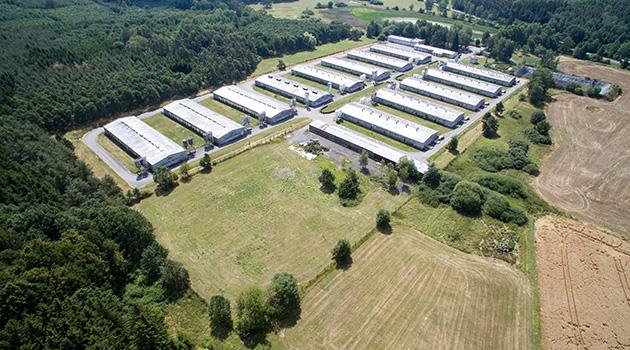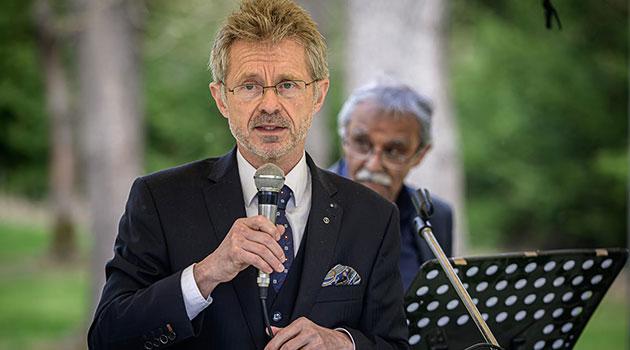Demolition of industrial pig farm located on the site of former WWII-era concentration camp for Roma to begin so Czech Republic can build new memorial

In Lety u Písku, Czech Republic, the demolition will begin on 22 July of the former industrial pig farm that overlaps the site of what used to be a concentration camp for Romani people during the Second World War, a move necessary to the building of a dignified memorial there honoring Holocaust victims of Roma and Sinti origin in Bohemia. Karolina Spielmannová, press spokesperson for the Museum of Romani Culture, which administers the site and is building the memorial, announced the news to Romea.cz.
Last opportunity to tour the industrial pig farm grounds
A total of 17 interested parties submitted bids for the demolition job. After assessing the content and formalities of the bids, the AWT rekultivace, a.s. bid was chosen and a contract will be signed with them for the work.
The cost of the demolition should not exceed CZK 110 million [EUR 4.5 million] and is being financed by the Czech Culture Ministry. “On 22 July 2022 at 13:00 CET, the winner of the public tender for the demolition of the facilities of the now-defunct industrial pig farm at Lety u Písku, Czech Republic will take charge of the construction site. This symbolic act begins the long-awaited demolition of the facility as a whole,” Spielmannová said in a press release.
As part of the event, figures from political and public life will speak who have been advocating for the new Lety u Písku Memorial to the Holocaust of the Roma and Sinti in Bohemia. Visitors will also be given one last opportunity to tour the grounds of the former industrial pig farm in the presence of activists and eyewitnesses to this history.
History: The industrial pig farm was built during the 1970s
The industrial pig farm, which was in operation from the 1970s until the spring of 2018, is located on the site of what initially was a disciplinary labor camp and later an internment camp; as of August 1942, the facility at Lety u Písku (just like its counterpart in Hodonín u Kunštátu) became what was called a “Gypsy Camp” where, unlike the two previous types of facilities located there, entire families of Romani people were imprisoned in inhumane conditions – and it thereby became a concentration camp. What was called the “Gypsy Camp I – Lety” saw 1,309 persons pass through it, of whom at least 326 died there.
Most of those who died at Lety were children. In 1943, immediately after the remaining children, men and women there were forcibly sent en masse to their all but certain deaths in the Auschwitz II-Birkenau Concentration Camp, the buildings of “Gypsy Camp I” were all razed to the ground and set on fire.
In 1995, near the mass burial ground for some of the victims who died in the Lety camp (located approximately 300 meters from the camp itself), a memorial was installed; the site became a Cultural Heritage Monument in 1998 and was then upgraded in 2012 by its then-administrator, the Lidice Memorial – an amphitheater was installed along with replicas of the prisoners’ quarters, a parking lot, and a trail with explanatory signage about the history of the site. Since 2018, the administrator of the Lety Cultural Heritage Monument has been the Museum of Romani Culture.
The Lety u Písku Memorial to the Holocaust of the Roma and Sinti in Bohemia
The Czech Government approved the buyout of the industrial pig farm for CZK 372,500,000 [EUR 15,000,000] exclusive of VAT in 2018. The Museum of Romani Culture was then entrusted by its establisher, the Czech Culture Ministry, with the task of demolishing the farm and building the new Lety u Písku Memorial to the Holocaust of the Roma and Sinti in Bohemia in its place.
The new memorial will be a dignified place for honoring the memories of the victims of the camp, and its aim is also to remind visitors of the tragic facts associated with the existence of the camp in the first place. Director of the Museum of Romani Culture Jana Horváthová says “the memorial must also educate visitors and inform them about the history of the Roma and Sinti in Bohemia in the 20th century, explaining the roots of the discrimination and hatred against them and galvanizing the discussion of human rights and how to improve our coexistence here.”
According to the project schedule, the demolition of the industrial pig farm will be followed by the first phase of building the new memorial, where a center for visitors will be constructed featuring an exhibition and a multifunctional hall. The revitalization of the Lety Cultural Heritage Monument will also take place.
This phase of the construction is significantly financed by the KU-PDP01-001 – Lety u Písku Memorial to the Holocaust of the Roma and Sinti in Bohemia project in the KU program for culture as part of the EEA Grants 2014–2021, and by the Czech Culture Ministry and Czech Finance Ministry. The project will continue in a second phase of implementing the landscape architecture design for the entire grounds of the memorial, including the exhibition’s outdoor components and the adaptation of the site of the former camp for the purposes of remembrance and reverence by building a Memory Trail leading from the building of the planned center for visitors to the memorial that will encircle the site where what was called the “Gypsy Camp” during the era of the Protectorate of Bohemia and Moravia once stood.
Main events related to memorializing the former concentration camp
– The building of a dignified remembrance site at the location of the former camp began to be discussed in 1995 and a memorial to the victims was unveiled near the industrial pig farm.
– In 1997, ministers Jan Ruml (Civic Democratic Party – ODS) and Pavel Bratinka (Civic Democratic Alliance – ODA) declared that they would propose the administration buy out the industrial pig farm, demolish it, and have a difnified memorial built on the site to the Holocaust and its Romani victims. The AGPI company, which owned the farm, then said it would be willing to relocate it in exchange for an “equivalent replacement”.
– The problem was kicked down the road after that: Resolving it was declared to be an aim of the cabinets of Václav Klaus (ODS), Josef Tošovský (unaffiliated) and Jiří Paroubek (Czech Social Democratic Party – ČSSD), and removing the farm and building a remembrance site was called a crucial matter in 1999 by Czech President Václav Havel and later by Czech Human Rights Minister Michael Kocáb (for the Green Party), and Czech Government Human Rights Commissioners frequently held negotiations on the situation.
– In April 2005, the European Parliament, as part of its resolution condemning discrimination against Romani people in the EU, adopted a call for the industrial pig farm to be closed. Shortly thereafter, Czech President Václav Klaus caused a stir by alleging that Lety had not been “a concentration camp in the proper sense of the term” and that it had never been intended for Romani people but “for those who refused to work”. That opinion caused outrage among many organizations run by Romani people and among other politicians.
– In April 2007, Czech Prime Minister Mirek Topolánek (ODS) announced that the administration would not have the money to relocate the farm. Similar statements were made in 2012 by Czech Prime Minister Petr Nečas (ODS) and, in May 2014, by Czech Prime Minister Bohuslav Sobotka (ČSSD), who said that the dozens of millions of Czech crowns necessary to demolishing the farm and building a new one elsewhere would be better used for educating Romani children or improving social conditions in socially excluded localities.
– In June 2010, near the site of the former camp, a remembrance site was opened including an amphitheater, two replicas of the original wooden quarters for prisoners, an exhibition commemorating the Roma victims of Nazism, a parking lot and new trails leading to the site. Czech Culture Minister Václav Riedlbauch said at the time that Czech Government Human Rights Commissioner Michael Kocáb was chiefly responsible for the creation of the site. The administration allocated CZK 21.4 million [EUR 876,000] to the project. Administration of the remembrance site was later assigned to the Lidice Memorial.
– In July 2013 the United Nations Human Rights Committee called on the Czech Republic to close the industrial pig farm.
– In May 2016, Czech Human Rights Minister Jiří Dienstbier (ČSSD) announced that the farm would apparently continue to overlap the site of the former concentration camp. He had held several meetings with the owners but no concrete conclusion ever resulted from them. At the beginning of August that same year, Czech Culture Minister Daniel Herman (Christian Democrats – KDU-ČSL) announced that the administration was close to an agreement to buy out the farm.
– In September 2016, Czech Finance Minister and head of the Association of Dissatisfied Citizens (ANO) Andrej Babiš became a target of criticism for remarks he made about the former concentration camp. According to a photojournalist for Aktuálně.cz, Babiš publicly alleged that it was a “lie” that Lety had been a concentration camp. He later apologized and distanced himself from the remarks. He then said he wanted to find the money to arrange for the farm to be bought and a memorial to be built in its place.
– In November 2016, the administration decided to commission an appraisal of the facility and on 13 July 2017, cabinet representatives submitted their offer to the AGPI company for its eventual purchase. The company’s General Assembly expressed agreement on 31 July with transferring the facility to the state, and on 7 August AGPI announced it would accept the Government’s offer to purchase it. The administration then approved the buyout of the farm on 21 August 2017, and on 23 October declassified the purchase contract, which revealed that the state was paying roughly CZK 372,500,000 [EUR 15,000] exclusive of VAT to do so.
– Representatives of the state took over the farm at the beginning of April 2018 and its demolition was spoken of as taking place by year-end. Later, however, Deputy Culture Minister René Schreier said the demolition was going to be more challenging than anticipated and would probably happen in 2019. According to Schreier, the demolition would be paid for by the Czech state (according to current information it will not exceed CZK 110,000,000 [EUR 4.5 million]) and the building of the memorial would be paid for by Norway Grants. In 2019 it was said that the demolition of the farm would happen in 2020 and the building of the memorial would begin one year afterward.
– The COVID-19 pandemic interferned with both the demolition preparations and the building of the memorial. In June 2020, nevertheless, the winner of the competition for the Lety u Písku Memorial to the Holocaust of the Roma and Sinti in Bohemia was announced as the design submitted by the Atelier Terra Florida and Atelier Světlík. Prior to that archeological work had also demonstrated that the biggest part of the former concentration camp for Romani people at Lety u Písku was located on the grounds of the farm, specifically in the location above its feed halls. Debris from the former concentration camp had still been visible there in the 1970s when the industrial pig farm was built during the communist regime.
